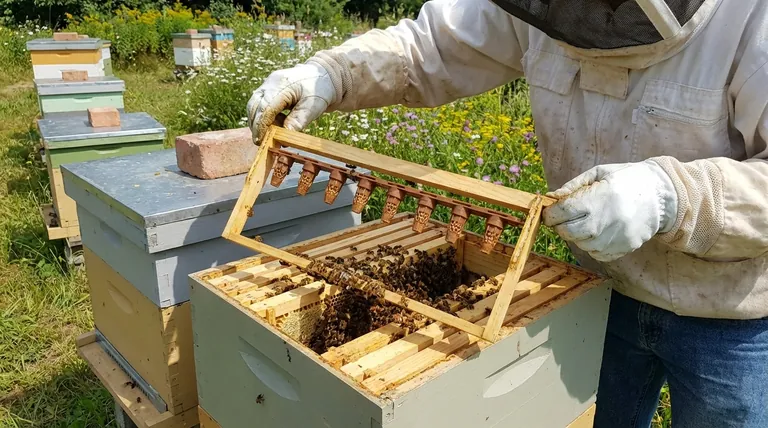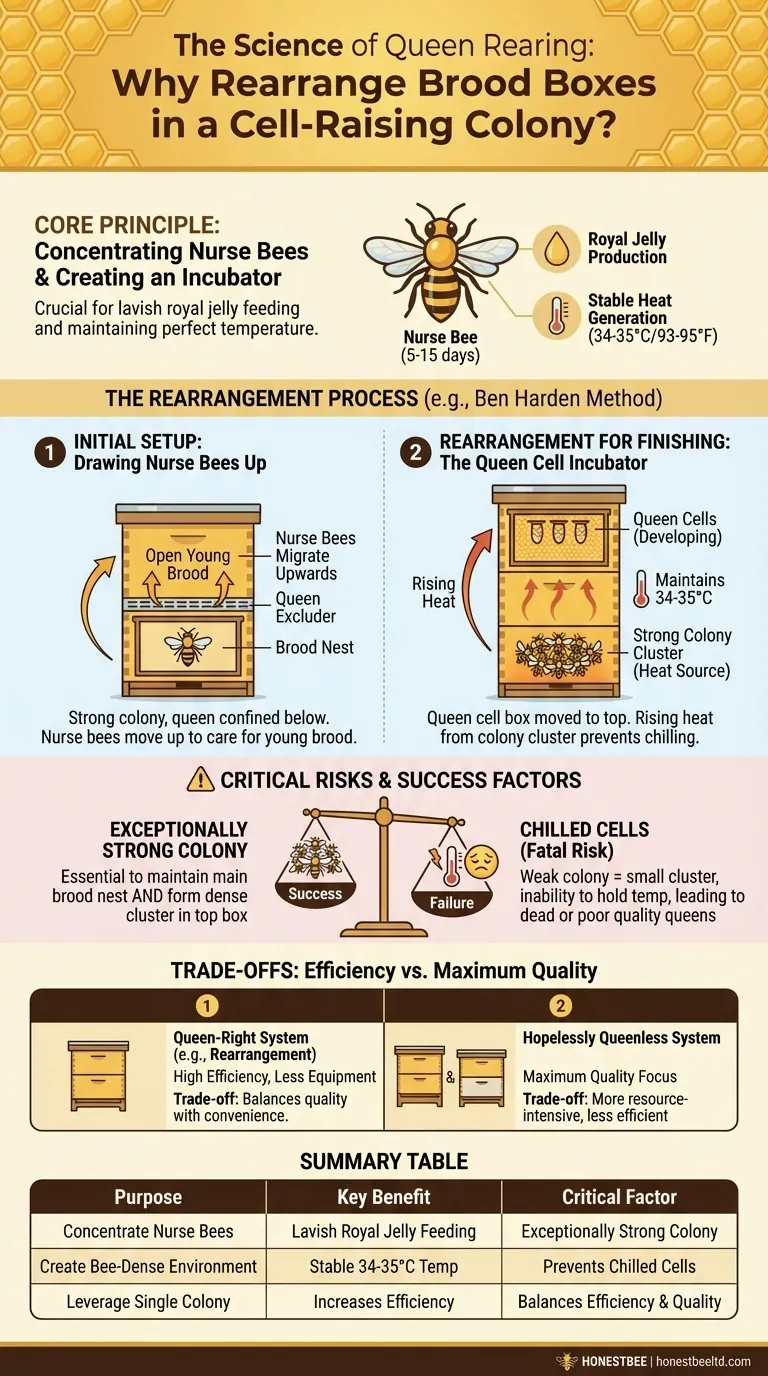In queen rearing, the primary purpose of rearranging brood boxes is to manipulate the colony's social structure and environment to create the ideal conditions for raising high-quality queen cells. This involves concentrating a massive population of nurse bees around the developing cells while ensuring a stable, warm temperature, all with minimal disruption to the colony.
The core principle is not just moving boxes, but engineering a "nursery" within the hive. By strategically rearranging components, you leverage the colony's natural instincts to focus the attention of its best caregivers—the nurse bees—onto the queen cells you want to raise.

The Core Principle: Concentrating Nurse Bees
To understand the rearrangement, you must first understand the role of nurse bees. These are young worker bees, typically 5-15 days old, whose primary job is to care for and feed the brood.
Why Nurse Bees are Critical
Nurse bees produce royal jelly, the protein-rich superfood fed to queen larvae. The quantity and quality of royal jelly a larva receives directly determines the final size, health, and reproductive capacity of the resulting queen.
A high concentration of nurse bees ensures that each queen cell is constantly attended, fed lavishly, and kept at the perfect temperature.
Creating a Bee-Dense Environment
Queen cells require a stable temperature of around 34-35°C (93-95°F) for proper development. A dense cluster of bees is essential to generate and maintain this heat, especially in a box that may be further away from the main brood nest.
Rearranging the hive is a method to create this bee-dense "incubator" environment precisely where you place your developing queen cells.
How Rearrangement Achieves This Goal
The technique you're asking about is common in queen-right "cell builder" systems, such as the Ben Harden method. This involves using one very strong colony for the entire process, rather than separate "starter" and "finisher" hives.
The Initial Setup
Typically, the system starts with a very strong, two-story colony. The queen is confined to the bottom brood box using a queen excluder.
The top box is filled with frames of open, young brood. This setup acts as a magnet for nurse bees, who move up through the excluder to care for the larvae, creating a high concentration of them in the top box.
The Rearrangement for "Finishing"
Once queen cells have been "started" (meaning larvae have been grafted into queen cups and accepted by bees), they need to be "finished" (fed and developed for the next 9-10 days).
This is where the rearrangement occurs. The box containing the frame of queen cells is often moved to the top-most position in the hive stack. The rising heat from the massive colony cluster below helps maintain the critical temperature, preventing the cells from becoming chilled. This is far more effective than leaving them in a less-populated box.
The "effort saved," as mentioned in the reference, comes from managing a single, strong colony instead of setting up and managing a separate, queenless finishing colony, which is a common alternative.
Understanding the Trade-offs and Critical Risks
While efficient, this method is not without risks and requires a deep understanding of colony dynamics. The success of the entire operation hinges on one key factor.
The Critical Importance of Colony Strength
This technique is only suitable for exceptionally strong, populous colonies. A moderately-sized colony simply does not have enough bees to both maintain the main brood nest and form a dense, stable cluster in a separate box high up in the hive.
The Fatal Risk of Chilled Cells
If the colony is not strong enough, the cluster of bees around the queen cells in the top box will be too small. They will be unable to maintain the required 34-35°C temperature, especially during cool nights.
Even a brief drop in temperature can damage or kill the developing queens, resulting in a complete failure or, worse, the production of weak, low-quality queens.
Efficiency vs. Maximum Quality
Using a single, queen-right colony is highly efficient. However, some beekeepers argue that the highest quality queens are produced in a "hopelessly queenless" finishing colony. In such a colony, the bees' desperation to raise a new queen ensures the cells receive maximum attention and resources. The queen-right method is a trade-off between high efficiency and absolute maximum quality.
Making the Right Choice for Your Goal
Deciding whether to use this method depends entirely on your resources and objectives.
- If your primary focus is efficiency and raising many cells: The rearrangement method is an excellent choice, provided you have exceptionally strong colonies that can support it without risking chilled cells.
- If your primary focus is maximum quality for a smaller number of cells: A dedicated, queenless finishing colony may be a more reliable and forgiving method, as the bees' focus is undivided.
- If you are new to queen rearing: It is often wiser to start with a simpler method, like the queenless finisher, to understand the core principles before attempting advanced, high-density systems.
Ultimately, successful queen rearing comes from understanding bee biology and using it to create the perfect environment for the task at hand.
Summary Table:
| Purpose of Rearrangement | Key Benefit | Critical Factor |
|---|---|---|
| Concentrate Nurse Bees | Ensures lavish royal jelly feeding for queen larvae | Requires exceptionally strong colony strength |
| Create Bee-Dense Environment | Maintains stable 34-35°C temperature for development | Prevents fatal risk of chilled cells |
| Leverage Single Colony System | Increases efficiency vs. separate starter/finisher hives | Balances efficiency with maximum queen quality |
Ready to Elevate Your Queen Rearing Success?
Mastering advanced techniques like brood box rearrangement requires not just skill, but also the right, reliable equipment. Whether you are a commercial apiary scaling up production or a distributor supplying the beekeeping community, HONESTBEE is your partner in success.
We supply durable, precision-engineered beekeeping supplies and equipment—including robust brood boxes, queen excluders, and hive components—designed to support the demanding environments of commercial queen rearing.
Let’s build stronger colonies together. Contact HONESTBEE today to discuss your wholesale needs and explore how our equipment can help you achieve consistent, high-quality results.
Visual Guide

Related Products
- Brown Nicot Queen Cell Cups for Breeding Queen Bees Beekeeping
- No Grafting Queen Rearing Kit: System for Royal Jelly Production and Queen Rearing
- Plastic Chinese Queen Grafting Tool for Bee Queen Rearing
- JZBZ Push-In Queen Cell Cups for Beekeeping
- JZBZ Type Wide Base Plastic Queen Cell Cups for Base Mounting and Queen Rearing
People Also Ask
- What role does the natural swarming process play in queen rearing? Harness the Swarm Instinct for Better Queens
- Why is it important to select a healthy larva less than 24 hours old for queen rearing? Maximize Queen Quality and Colony Strength
- What should be done with extra queens from grafting? A Strategic Guide for Apiary Management
- What are the ideal conditions for raising good queen cells? Achieve Robust Queens with Strong Cell-Builder Colonies
- How many cells are given to a nucleus? Understand the One-to-One Rule in Cell Biology



















